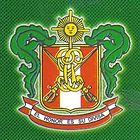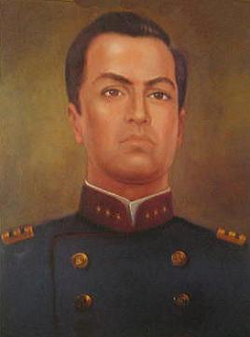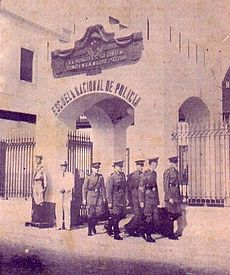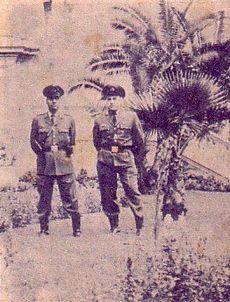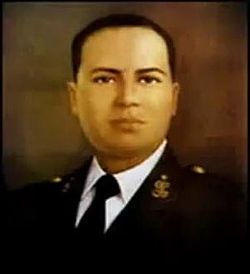- Civil Guard (Peru)
-
Civil Guard
Guardia CivilCoat of arms Motto El Honor es su divisa Honor is its emblem Agency overview Formed 1873 Dissolved 1988 Superseding agency National Police of Peru Legal personality Governmental: Government agency Jurisdictional structure National agency Peru General nature Operational structure Notables People - Fernando Rincón Jaramillo, General
- Alipio Ponce Vásquez, Captain
Anniversary - August 30
The Civil Guard (Spanish: Guardia Civil) in Peru was formed as main preventive police force of Peru in 1922. It was organized and trained by a Spanish police mission sent to Peru at that time. It was not a detective force, investigations being carried out by the Investigative Police of Peru founded in the same year, while the old Republican Guard still had certain police missions. The Civil Guard was later renamed the General Police, which merged into the new National Police of Peru in 1988.
Contents
Mission
The Guardia Civil Benemérita Peru (now the National Police of Peru) was the corps of police that had as its mission: maintaining public order, while not requiring the use of armed force and the prevention of crimes and misdemeanors, the protection of people and their property, maintaining the free movement on public roads, vehicular traffic control, among others. Depended from the Ministry of Interior.
Creation of the Civil Guard
The origins of the Guardia Civil of Peru dates back to 1873, when President Don Manuel Pardo and Lavalle, two Supreme Decrees endorsed by the December 31 of 1873 (published in the Diario Oficial "El Peruano" on January 28 of 1874) and March 23 of 1874 provides for creation. By Supreme Decree signed on December 31 of 1873, with legislative approval April 3 of 1874, reorganized the police in the following manner:
- “Organization of the Vicinity", composed by the residents against criminals, by the Mayors.
- “Police Special Services", composed of the Security Police in markets and public places.
- “Police for Establishments".
- “Country Police".
- “Prison Guards".
- “Ports Police", regulated by the Navy.
- “Organization of the permanent Public Force", for the preservation of public order, preventing crimes in the cities and others.
It also refers to "urban and rural stations and of the Regular Police Force divided into Gendarmerie and the Guardia Civil. [1]
On November 9 of 1874, President Don Manuel Pardo and Lavalle School of Education created the Civil Guard, which was formed by a company of 50 mounts in the Battalion of Infantry Gendarms of Lima.
During the War with Chile, Peru's Civil Guard would have a notable perfomance fighting alongside the Army of Peru and is in the Battle of Tarapacá where excels the Constable CG Mariano Santos Mateos, whose work was critical to the Army of Peru obtained the victory in such action weapon. Mariano Santos Mateos, the Brave of Tarapacá, belonged to the Infantry Battalion "Guards of Arequipa" No. 25, Unit consisting of six companies of Civil Guards, and managed to capture, in the battle, for the Peruvian weapons, the regimental Colonel (flag) of the "2nd Line" Infantry Regiment of the opponent Army being congratulated by his action and was promoted to the next higher grade of Inspector of the Guards of the Civil Guard of Perú.
Reorganization
The formation of the former police lasted until 1919, the year in the second government of Don Augusto Bernardino Leguía Salcedo decided to reorganize through a Legislative Decree No. 1163 issued on August 7 of 1919. Among other things provided for the establishment of "a school for aspiring police officers and individuals in the institution."
As the purpose of President Leguía was taken as a model Police Spain, asks the government of His Catholic Majesty the King of Spain Don Alfonso XIII, sending to the capital of Peru on a Spanish police mission to organize and instruct the Peru to the police of the republic. Leguía through Supreme Resolution of April 4 of 1921, has a mission to recruit the Benemérita Guardia Civil from Spain, to establish the basis on which the Civil Guard should be formed of Peru, which came, and stood out, sign up at Madrid on October 1 of 1921, the diplomatic settlement that were recruited by the services of a Mission Benemérita Guardia Civil Spanish, the same as the November 22 of 1921 came to the capital of Peru and was chaired by then Lieutenant Colonel GCE Spain Mr. Pedro Pueyo. Completing the mission Captain Lord Bernardo Sanchez Visaires GCE, GCE Lord Lieutenant Adolfo Parreño Carretero, who due to illness had to return to Spain, and was replaced by the same class of CGE Lord Lieutenant Fernando Gomez Ayau and the 1st Sgt GCE Mr José Gómez Hernández (First Guard instructor).
The Spanish police mission, after installed, went to work planning and formulation of projects for the reform of the police, delivering within a month of their arrival, the documentation on January 21 of 1922, having presented to the President Leguía and the Minister for Police and Leguía Germán Martínez, 14 bills that comprise the complete plan of reorganization of the Civil Guards, Safety and Security of the entire republic. This study was approved by the chairman of the Leguía, who considered the plan proposed in the 14 projects mentioned, the only hacedero the reorganization, for his excellent ways of adapting the economy and that despite the improvement of all services involved.
Creation of the School of Police of the Republic
As a result of work carried out by the Spanish Police Mission, the government issued on 1922, July 3 a Supreme Decree stipulating in its operative part the creation of the "School of the Civil Guard and Police of the Republic. "The purpose was to organize a Civil Guard Corps similar to Meritorious Civil Guard of Spain on the base of the Gendarmerie of the Republic. Also form another Corps called Security or Public Order Corps on the base of the old Town and Country Civil Guard as well as establish another Corps called Watching and Investigation, with the profitable elements of the Investigations Section of the Police Administration and first sergeants, graduates of the Army, or of the same who served as assimilated officers in the existing Gendarmerie.
The School of Police of the Republic initially consisted of three sections namely:
- The 1st., Superior for Officers for the three Corps.
- The 2nd., for Troop and Aspirings class for the three Corps.
- The 3rd., Special, for Aspirings Watching and Investigation Section and its fingerprinting annex.
After created the School of Police and Civil Guard Supreme Decree of July 3 of 1922, there were first and a very careful recruitment of qualified personnel for the installation of the campus, getting the nomination very honorable and excellent military history for the kind of Captains, Lieutenants and Alféreces. Class sections for security and investigation were met with great care to conduct background and education and to that extent that he was a personal honor, on the opening day of school, their recruiters and trainers.
The location chosen for the School of Police of the Republic was the former Hospice of Mercy Hospital and Insane, located at Avenida Sebastian Lorente Ibáñez No. 769 (Avenue of the Incas before) the traditional district of Cercado, which was in ruins, decided that the restoration and adaptation, which had already beginning the April 1st of 1922 is under the personal inspection of Lieutenant Colonel GCE Spain Mr. Pedro Pueyo, head of the Spanish Mission, and transforming providing it with all the necessary elements for the perfect operation of this kind of institutions.
The School of Police of the Republic was inaugurated on November 1 of 1922, when President Leguía, who presided over the ceremony, the government in full, with diplomatic and consular corps accredited in Lima, the military and civilian component of the population and the Spanish colony of Lima, which, in response to the initiative suggested by the Lord Lieutenant-Colonel Pedro Pueyo GCE and Spain, gave the institute the "flag of war."
The opening of the school was carried out with the discovery of the plaque, followed by the blessing of the flag of war by Mr Apostolic Nuncio, the delivery of it to the president Leguía: by the godfathers of Mrs Fabiola Ojeda, wife of Minister of Spain and the President Casino on behalf of the Spanish colony Spanish; acceptance of the offering by the President of the Republic, delivered it to the school GCE Lord Lieutenant Colonel Pedro Pueyo and Spain for the surrender in then to the campus. This act followed the delivery of the flag-bearer and his bodyguard, then Lieutenant-Colonel Lord GCE Pedro Pueyo going to Spain and trained forces proceeded to take the oath of allegiance regulation, which was answered with stentorian voice from students, was the parade of all pupils within the folds of the shows that were sworn to defend at the expense of their blood on the cross and that it was Lieutenant Colonel Pedro Pueyo and Mr. GCE Spain with his sword.
Descorrió is below the monument to the gratitude of the new institutes was erected in honor of President Leguía. Magnificent bronze bust that stood in the center of the courtyard of honor at the school, who performed the act of Mrs Fabiola Ojeda accompanied by Minister of Foreign Affairs, Mr Solomon Dr Alberto Osorio and awoke again cheers and applause in honor of the president. Completed visited the splendidly gifted to guests.
At the request of Lt. Col. Pedro Pueyo and Mr. GCE Spain, at the entrance to the school and so blatant, placed a large banner characters, with the motto that inspired the Benemérita Guardia Civil of Spain: "The honor is his currency " to which the president Leguía supplemented with the phrase:" As in the motherland. "
The School began operations on November 4 of 1922, graduated on September 3 of 1923 the first batch of Civil Guards totaling up to 1988, promotions for 58 officers.
The strength of the first class graduates from the Police Academy, addressed the Commissioners for Lima, constituting the security forces.
The cavalry was formed under the name of the Cavalry Squadron of Provincial Safety, which was organized on the Cavalry Squadron Gendarmes "Lima Guard" at the "Quinta de Presa."
Subsequently organized the First Infantry Regiment of the Security constituted by battalions, which in turn merged with the Commissioners for Lima. Then, these units are spread throughout Peru, with the names of the Security Battalions of the North, Central and South, with offices in Trujillo, Arequipa and La Oroya respectively.
Similarly, the August 18 of 1924 establishing the first Joint Command of the Guardia Civil, with an Infantry Battalion, composed of two companies, and a Cavalry Squadron (formed on the basis of the former Police on horseback) . Its investigation began the same month, graduated in 1925, being the highlights of the two Civil Guards infantry company headquarters to the San Lazaro is located at Calle Matamoros, in the Rimac and the Cavalry Squadron of the Cuartel shred Conchucos in the Barrios Altos, Lima, headquarters that the years would become the headquarters of the Cavalry Squadron Guards School of the School of Police and the Guardia Civil to the end of 1965 they moved to the Center for Instruction Civil Guard (now School Officers PNP) Mariano Santos "in the Countryside, Chorrillos.
On January 14th of 1929 the Traffic Battalion was created, a merit of Act No. 6468, to control traffic in the Capital of Peru, named Major GC Edilberto Salazar Castillo as its first chief. The service was started in November of that year.
Augusto B. Leguía reorganize the Corps Security Forces of the Republic, by decree of the Supreme March 17 of 1930, with the autonomy of the role of cavalry in the Police Cavalry Squadron and the Provincial Security becomes the First Cavalry Regiment Security, moving the entire unit Caballería Thriller, jockeys and horses, the "Quinta de Presa" the Barracks "The Potato", ratified at GC Col. Rufino Manuel Martinez Martinez as Head of the First Infantry Regiment of the Security and appointed Lieutenant Colonel Manuel GC Pella Cáceda as First Chief of the First Cavalry Regiment based at the Security Headquarters "The Potato."
With the reform of the January 5th of 1944 the Corps of the Guardia Civil and Security were merged into one body called the Civil Guard. Under a government mandate that the staff responsible for providing services in the towns were called Urban and Civil Guard, which they did in the fields, Rural Civil Guard.
Since then, the Guardia Civil of Peru was evolving face since 1980 the serious problem of subversion, increasing its strength, taking on new tasks and creating different specialties.
Unification of the Police Forces
The president Alan García Pérez, in his first government, launched on September 14 of 1985, under the law, Congress approved 24,294 of the Republic, a reorganization of the police force.
On February 4 of 1986, continuing with the project undertaken, legislative decrees were issued Nros. 370, 371, 372 and 373 relating to the Organic Law of the Ministry of the Interior, the Code of the police force, Organic Law of the Civil Guard, Police Department and the Republican Guard.
Legislative Decree No. 371 "Code of the police force" laid the foundations for the creation of the final National Police of Peru.
The Act establishes a single command (ie the Directorate General of police forces) and also the formation of a single study center for the preparation of police officers (known as the School Officers of the police force based at the former Center Instruction de la Guardia Civil "Mariano Santos" in The Countryside - Chorrillos) and a national school for the guards and agents (referred to National Police headquarters at the former Center for Instructional Republican Guard in Puente Piedra).
On November 7 of 1988 was enacted Law 24,949 of December 6 of 1988 amending the relevant articles of the Political Constitution of Peru of 1979 finally created the National Police of Peru.
The objectives sought were, among others, to integrate the three police forces to make better use of economic resources, eliminate the conflict that existed between them caused by "double role" and, above all, provide better service to society.
With the unification of the Civil Guard police force became known as "General Police (Police General) until 1991.
Ranks and titles
The police grades in the Civil Guard are the following:
1. General Officers:
- Lieutenant General.
- General.
2. Superior Officers:
- Colonel.
- Lieutenant Colonel
- Majour.
3. Subaltern Officers:
- Captain.
- Lieutenant.
- Ensign.
4. Under-Officers:
- Superior Under-Officer.
- 1st Under-Officer.
- 2nd Under-Officer.
- 3rd Under-Officer.
5. Classes and Constables:
- 1st Sergeant
- 2nd Sergeant
- Corporal
- Constable
The Anthem of the Peruvian Police (Civil Guard of Peru)
Anthem of the Peruvian Police (Civil Guard of Peru)
Músic: Miss Angélica Pagaza Galdo.
Lyric: Dr. Marcial de la Puente Dianderas
Year: 1938
- O policemen, in a hymn of glory
- Let us praise our noble mission;
- satisfied with being what we are,
- the great warriors of abnegation.
- From the old Spanish noble Mother's
- Meritorious Institution,
- we shall follow its living examples,
- we shall hold up the heroic blazon.
- O policemen, in a hymn of glory
- Let us praise our noble mission;
- satisfied with being what we are,
- the great warriors of abnegation.
Patron of the Civil Guard of Peru
Captain CG Alipio Ponce Vasquez was born in 1906 in the District of Apata province Jauja, department of Junín, joined in 1924 as a Student-Guard, the "School of Police and Civil Guard" with egresando Class Guard Security Corps of the Republic, on March 15 of 1925. It amounts to the CS Cabo July 21 of 1927, a Sergeant 2nd. CS on March 10 of 1930 and the 1st Sgt. CS on October 10 of 1932.
In 1931 he was appointed instructor in the School of Police and Civil Guard. After his promotion to Sergeant 1st. he was assigned to the 1st. Comandancia de la Guardia Civil y luego a la Primera Compañía del Batallón de Seguridad del Norte (Command of the Guardia Civil and then to the First Security Company of the Battalion of the North) which provides services to early 1935.
On April 3 of 1935 became a Sub-Officer-to-School Student of the School Officers of the Guardia Civil and police, and January 7 of 1937 as a graduate Ensign GC, going to serve in various units until 1940.
For the degree of promotion is 1st Lt. GC. March 1941.
When the events of 1941 on the northern border, Lt. GC Alipio Ponce Vasquez was assigned, after service in the province of Huanta, department of Ayacucho - on March 25 at the Civil Guard Detachment established the Northern Border , as an officer of the First Company who then commanded the Captain GC Conrado Ruiz Oliva.
Participated in the decisive Battle of Zarumilla, achieving notable victories in the stock of weapons that culminated in the taking of Quebrada Seca, Carcabón and Huabillos. It was in taking the post of Lieutenant Carcabón where GC Alipio Ponce Vasquez on July 25 of 1941, under the command of thirty civil guards and infantry of the Army of Peru from his post after 25 minutes of action, managed to dislodge the forces opponents, raising the mast the national flag. The next day launched a surprise attack against Huabillos position, the enemy could not contain.
On September 11 of 1941 was killed during a reconnaissance, when his group was ambushed in the valley Porotillo (Ecuador).
Twelve days after his death by Supreme Decree 23 September 1941, the Peruvian Government awarded him the posthumous promotion to the grade of captain of the Guardia Civil. On September 10 of 1966 inaugurated a bust commemorating his actions in the square "Captain GC Alipio Ponce Vasquez" located on the sixth block of Jirón Apurímac in Callao.
The headquarters of the 27th. Command of the Guardia Civil (Police Region today) of Callao and Educational Center of the Guardia Civil (now PNP) have his name.
During the Government of the EP Division of General Francisco Morales Bermúdez Cerrutti by Supreme Decree No. 28-78-IN of August 29 of 1978 is declared a hero of the Civil Guard (now PNP) Captain Alipio Ponce Vasquez.
By Supreme Resolution No. 2269-78-GC/SG of September 4 of 1978 is declared patron of the Guardia Civil (now PNP) Captain Alipio Ponce Vasquez.
Congress declared it a national hero by Law No. 24658 April 24 of 1987, ordering that his remains rest in the Crypt of Heroes.
On September 11 of 1987 Benemérita the Founders Society of Independence, Winners of the May 2 of 1866 and Qualified Defenders of the Fatherland incorporated in its National Heroes Gallery Captain GC Alipio Ponce Vasquez.
Notes
1. ↑ El Artículo 14º del Capítulo IV del Decreto Supremo rubricado el 31 de diciembre de 1873 , textualmente dice: “ La Fuerza Regular de Policía se divide en dos Clases: Guardia Civil y Gendarmería ” (la ultima a caballo y con labor de Policía Rural). (Article 14 of Chapter IV of Decree signed on December 31 of 1873, reads: "The Regular Police Force is divided into two classes: the Civil Guard and Gendarmerie (the last horse to work with Police and Rural)).
Bibliography
- Album del Cincuentenario de la Guardia Civil del Perú, 1972, artículo: Breve Reseña Histórica de la Policía en el Perú . Album of the Fiftieth Anniversary of the Civil Guard of Peru, 1972, article: Brief History of the Police in Peru.
- Revista de la Guardia Civil del Perú, Año L, Nº 400, Noviembre-Diciembre 1982, folleto adjunto: La Guardia Civil del Perú (páginas desglosables) . Revista de la Guardia Civil del Peru, Year L, No. 400, November–December 1982, attached brochure: The Guardia Civil del Peru (pages broken down).
- Revista de la Guardia Civil del Perú, Año LVI, Nº 434, Noviembre-Diciembre 1988, artículo: Historia de la Guardia Civil del Perú refleja abnegación, sacrificio, patriotismo y heroicidad a la patria ya la sociedad, que la cubre de gloria e inmortalidad, páginas 10-20 . Revista de la Guardia Civil del Perú, Año LVI, No. 434, November–December 1988 article: History of the Guardia Civil of Peru reflects dedication, sacrifice, heroism and patriotism to the nation and society, which covers the glory and immortality , pages 10–20.
External links
- Policía Nacional del Perú Official site
- Museum of the Policial del Perú
- The Spanish Guardia Civil
- La Guardia Civil y Policía en la Guerra del Pacífico (the Civil Guard and Police in the War of the Pacific)
- Benemerita Guardia Civil del Perù "El honor es su divisa"
- Héroes of the Guardia Civil del Perú
- Himno de la Guardia Civil del Perú
- Police march "Los Caballeros de la Ley"
Categories:- Defunct law enforcement agencies of Peru
- Gendarmerie
- Internal conflict in Peru
Wikimedia Foundation. 2010.

